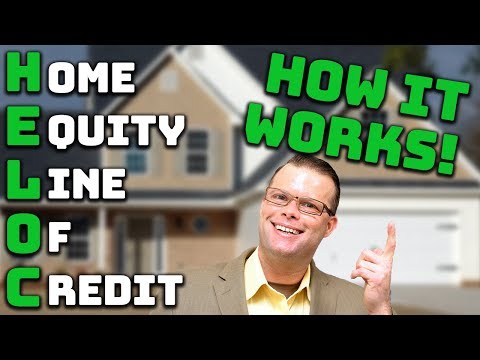Navigating the HELOC Landscape: Understanding How Home Equity Lines of Credit Work
When you feel like the walls of your home are not just physical barriers but also financial vaults, you know it’s time to talk HELOCs. Home equity lines of credit (HELOCs) might sound complex, but let’s demystify this financial tool together. Simply put, a HELOC allows you to borrow against the equity of your home, giving you access to a revolving credit line to use as needed.
A key distinction is that a HELOC is not the same as a home equity loan. So what’s the difference? A home equity loan is a lump-sum loan with a fixed interest rate, while HELOCs offer flexible borrowing options with variable interest rates. This flexibility means you can borrow, repay, and borrow again up to your credit limit. And remember, how to get a home equity line of credit begins with understanding these distinctions.
Let’s zoom in on how do home equity lines of credit work. With a HELOC, you’re approved for a specific credit limit based on the equity you’ve built in your home. It’s almost like having a credit card secured by your home’s value. You can borrow what you need when you need it, making HELOCs a go-to for financial flexibility.

Meeting the Bar: Home Equity Loan Requirements in 2024
Fast-forward to 2024, and the world of HELOCs keeps spinning. The typical requirements from lenders are now more finetuned. Borrowers need substantial equity in their homes—usually up to 85% of the home’s value minus any outstanding mortgage debt. For example, if your home is worth $300,000 and you owe $100,000, you could potentially access up to $155,000 in a HELOC.
Recent economic ebbs and flows have nudged lending criteria here and there. A solid credit score—Experian rings that bell at a minimum of 680—continues to be essential. Lenders also zero in on your loan-to-value (LTV) ratio, which in layman’s terms means they’re checking how much loan you’re juggling against the value of your home.
Now, remember that jigsaw puzzle called the home equity loan requirements? Seeking a HELOC thinking, “I’m golden as long as my credit is not down in the dumps,” won’t cut it. There’s the debt-to-income ratio (DTI), which is a measure of your monthly debt payments compared to your income. It is the lender’s way of knowing you’re not biting off more than you can chew.

| **Step** | **Details** | **Explanation/Requirement** |
|---|---|---|
| 1. Determine Eligibility | Available Equity | You must have more than 20% equity in your home. |
| 2. Calculate LTV Ratio | Loan-to-Value (LTV) Rate | Typically, the LTV must be 80% or lower to qualify. |
| 3. Check Credit Score | Minimum Credit Score | A credit score of 680 or higher is generally required. |
| 4. Gather Financial Documents | Proof of Income, Debts, Asset Statements | Lenders will review your financial health. |
| 5. Estimate Borrowing Capacity | Borrow Up to 85% of Home’s Value | Subtract the amount owed from the home’s value and multiply by 85%. |
| 6. Research Lenders | Compare HELOC Offers | Look for competitive interest rates and terms. |
| 7. Apply for HELOC | Submit Application | Provide all necessary documentation to the lender. |
| 8. Complete Home Appraisal | Property Valuation | The lender will require an appraisal to determine the home’s current market value. |
| 9. Review Terms | Interest Rates & Repayment | Understand the HELOC’s interest rate, term, and monthly payment. |
| 10. Finalize HELOC | Closing Process | After approval, complete any final paperwork and close the line of credit. |
Chase Home Equity Line of Credit: A Case Study in Flexibility and Value
Chase takes the home equity game very seriously, providing options that keep borrowers smiling. An attractive chase home equity line of credit offers potential benefits like competitive rates and a degrees-of-freedom style flexibility that can be a godsend for your finances.
Customers using Chase HELOCs often rave about how it smoothened the bumps on their financial roads. Take Amy Sullivan, who faced an emergency roof replacement. For her, the Chase HELOC was a true lifesaver, combining convenience and value, and offering a financial umbrella just when she needed one.

Heloc vs Home Equity Loan: The Great Debate
It’s the financial showdown we’ve all been waiting for: HELOC vs. home equity loan. Each has its champions and critics. With a HELOC, you’ve got variable interest rates and a “pay-as-you-borrow” approach. Conversely, home equity loans are more like your traditional loans with fixed rates and a set repayment schedule.
Need big money for a one-off project? A home equity loan might be your buddy. But if your cash needs come in waves, the heloc vs home equity loan discussion leans towards the flexibility of a HELOC. Financial gurus share their two cents saying, “It’s about alignment,” advising borrowers to match their loan type to their financial scenarios.

How to Get a HELOC: A Step-by-Step Guide
How to get a heloc isn’t a guarded secret, but it requires due diligence. Kick things off with a financial self-assessment. Check your credit score—is it singing or sobbing? Next, evaluate the equity you’ve built up in your home. Remember, banks like Chase could let you borrow a nice chunk of your home’s value.
With your financial ducks in a row, approach lenders with confidence. Be eagle-eyed when reviewing terms, and don’t be shy to negotiate. Understanding What Is a line Of credit will put you streets ahead in the conversation. Clear as a bell? Not quite? Consider your options like Quicken Home And Business to potentially manage your financial intricacies.

Unlock 5 Insane Benefits of Home Equity Credit:
1. Tap Into Cash for Big Projects or Emergencies
Imagine you wake up to a flooded kitchen or dream of adding a sunroom. A HELOC offers the financial equivalent of a Swiss Army knife. Let’s say you want to redo your kitchen, that’s where the HELOC shines, providing the cash flow just when you need it.
2. Potential Tax Advantages for the Smart Borrower
Uncle Sam could offer you a wink with potential tax deductions on HELOC interest payments. Careful, though—this is no replacement for a seasoned tax advisor’s guidance. Every dime counts, and knowing What Happens To Your debt When You die or how it’s taxed when you’re alive is pure gold.
3. Flexibility in Borrowing and Repayment
HELOCs could win an Olympic medal for financial gymnastics. You have the power to draw from the line of credit at any time, only paying interest on what you use. It’s a tool that lets you match your borrowing with your cash flow needs, no matter how erratic they might be.
4. Credit Score Enhancement through Credit Utilization
A HELOC could be your credit score’s personal trainer, helping you bulk up that score through sensible borrowing and repayments. Manage your HELOC correctly, and watch your credit profile flex those muscles!
5. Lower Interest Rates Compared to Other Credit Forms
This perk is a heavy lifter. HELOCs usually boast lower interest rates than credit cards or personal loans, making them the smarter choice for substantial financial needs. It’s a long-term boon, saving you green on the interest front.
The Power of Information: How to Get the Most Out of Your HELOC
Smart homeowners know their HELOC inside out. They wield it like a financial tool, aligning short-term needs with long-term aspirations. Knowing the ins and outs of What Is equity in a house empowers you to use your HELOC wisely, keeping you ahead in the game of homes.
Conclusion: The Key to Unlocking Your Home’s Financial Potential
From understanding how to get a home equity line of credit to tapping into the equity for life’s big swings, a HELOC could be your golden key. Each financial situation is unique, but the potential a HELOC offers is universal. With wisdom and smart strategies, you could step into a future where your home not only shelters you but also shores up your financial wellbeing.
As we peek into the future, consider the evolving landscape of home financing. HELOCs stand as a testament to innovation in personal finance—think of them as the adaptable, dependable financial companions for modern homeowners. Whether it’s bolstering your cash flow, prepping for unexpected expenses, or fueling your home’s value through improvements, HELOCs offer a world of possibilities. Why not see if unlocking your home’s equity could be the master move in your financial strategy?
With eyes on the horizon, homeowners who grasp the potential of their home equity are the ones poised to thrive. Don’t just live in your home—let it lift you to new financial heights.
Mastering the Game: How to Get a Home Equity Line of Credit
Who would’ve thought that the key to unlocking some seriously insane financial opportunities would be nestled right in the comfort of your own home? That’s right, folks! We’re digging into the nifty world of home equity lines of credit—kind of like finding hidden treasures behind your own Doors Of stone—except these doors swing wide open with a bit of know-how. So, lace up your pointed toe Heels because we’re about to strut through some high finance fashion.
Step 1: Brush Up On Your Home Equity Smarts
Hold your horses! Before you start signing papers, you gotta understand what you’re dipping your toes into. Think of How Does a home equity loan work as your Financial 101 course. It’s a must-read, like that thriller you couldn’t put down, explaining the A to Z about dipping into your home’s value while you still live in it. Knowledge is power, my friends, and in this case, it’s the secret ingredient to unlocking doors you didn’t even know you had.
Step 2: Check your Equity – Are You Ready to Rock?
Your home equity isn’t just a figure—it’s your red carpet invitation to the ball, baby! To figure out if you’ve got enough equity, imagine your financial scenario like the plot of an exciting Bokeem woodbine movie. You don’t want any plot twists like owing more on your mortgage than what your house is worth. So, you gotta snoop around for the juicy details: your current mortgage balance and your home’s market value. Get those right, and you’ll be in business.
Step 3: Scout for the Best Lender – They Should Woo You!
It’s tempting to jump at the first offer, but pause right there, partner. Shopping around for a lender should be like dating—you’re looking for “The One.” You want a lender that will woo you with good rates and groovy terms, not tie you down with financial ball and chains. So, before you commit, play the field and compare offers. Remember, it’s not just about the rates. It’s about the relationship, too. Does this lender make you want to write love songs, or are they leaving you cold?
Step 4: Red Tape Rodeo – Getting Through the Paperwork
Yeehaw! Get ready to saddle up and ride through the paperwork prairies. Applying for your line of credit is like an auto insurance With no down payment deal—it sounds too good to be true, but with the right rodeo skills, you’ll make it look easy. Gather all your financial docs, like income proof, tax returns, and that statement from your current mortgage. It’s showtime, and you want to impress those lenders with your smooth moves and smarts!
Step 5: Use it Wisely – Your Golden Egg
Once you’ve got those funds in hand, don’t start spending like there’s no tomorrow. This isn’t Monopoly money; it’s the golden egg, and you’ve got to be the savvy goose. Invest in smart renovations that boost your home’s value or consolidate debt to upgrade your financial health. Just remember, with great power comes great responsibility—use it wisely, or you may just squander your treasure trove.
Well, folks, isn’t that a rip-roaring ride through the world of home equity lines of credit? Keep these nuggets of wisdom close to your vest, and you’ll be crafting your financial success story in no time. Now, don’t be shy—go forth and conquer the world of mortgages like the savvy homeowner you are! 🏠💰

Is it hard to get home equity line of credit?
Getting a home equity line of credit (HELOC) can feel like a tightrope walk, but it’s not necessarily Mission Impossible. Your ability to snag one largely hinges on your credit health, how much equity you’ve built up in your home, and your debt-to-income ratio. If those numbers look as sweet as pie, you’re in a better spot, but if they’re rockier than a mountain trail, you might find yourself hitting a bit of a snag.
What is the monthly payment on a $50000 HELOC?
Calculating the monthly payment on a $50,000 HELOC is a bit like trying to nail jelly to the wall—it can fluctuate since HELOCs often have variable rates. However, during the draw period, you might only have to pay the interest, which could be as low as a couple hundred bucks a month, depending on your rate. Just remember, once the repayment period kicks in, you’ll be paying principal plus interest, and that’s when the monthly nut can get a bit tougher to crack.
What is the monthly payment on a $100 000 home equity loan?
If you’re eyeing a $100,000 home equity loan, your monthly payment’s a pretty straightforward number magic. It depends on your interest rate and loan term. Say you snagged a sweet deal at a 5% interest rate over 15 years—your monthly payment could dance around $790. But don’t forget, that’s not chump change—it includes interest and principal, so the numbers can swing based on the term and rate.
What credit score is required for a home equity line of credit?
Strap on your credit score boots! For a HELOC, lenders typically look for a credit score that’s standing proud at about 620 or higher. Higher scores can pave the way to more favorable terms, while lower scores might send you back to the drawing board.
Do I need an appraisal for a HELOC?
Whew! The word “appraisal” can make seem like opening Pandora’s box, but yes, you often need one for a HELOC. Lenders like to know your home’s current market value to figure out how much dough they’re willing to offer. Sometimes, though, if your lender’s feeling generous or if you’ve got an existing relationship, they might just run an automated valuation or drive-by appraisal to get the ball rolling.
What are the disadvantages of a home equity line of credit?
Hold your horses before jumping on that HELOC wagon! Some disadvantages include unpredictable payments (thanks to those variable interest rates), the temptation to overspend since it’s like a cash buffet, and putting your home on the line, literally—as in, you could lose it if things go south. Plus, there could be extra fees and penalties that hit your wallet surprisingly. It’s certainly not all sunshine and rainbows.
What is the payment on $150000 home equity loan?
Ready for some number-crunching? On a $150,000 home equity loan, if you rope in a 5% interest rate over 15 years, you’re looking at a monthly installment of about $1,186. But remember, this is a ballpark figure. Actual payments can vary based on your loan’s term or rate.
What is the payment on a 25000 home equity loan?
For a $25,000 home equity loan, let’s paint a picture with a 5% interest rate over a 10-year stretch. Your monthly payments are probably gonna land somewhere near $265. But, don’t forget to factor in your credit history and job stability—they can either play nice or rain on your parade when it comes to your actual rate.
What is the payment on a 20000 home equity loan?
If you’re pondering the payment on a $20,000 home equity loan, let’s say you lock it down at 5% over 10 years. Your monthly dues could hover around $212. But hey, that’s just shooting from the hip—your actual payments depend on your credit score and how well you’ve courted your lender.
What bank has the best home equity loan?
In the world of home equity loans, picking a winner can be as tricky as a game of musical chairs. However, some players often stand out—credit unions and community banks can offer personalized service and competitive rates. But don’t count out the big guns—some nationwide banks roll out red carpet deals too. Who’s the best? It’s really about who’s playing your tune when it comes to rates and service.
Is a HELOC a second mortgage?
Yes, siree, a HELOC can indeed take on the role of a second mortgage, staking its claim on your home right behind your first mortgage. It’s like the backup singer that can still belt out a tune—important and powerful, but not the star of the financial show.
How long does it take to get a HELOC?
Racing towards a HELOC can seem like you’re stuck in the slow lane. Typically, it can take about 2 to 6 weeks to get from application to approval. But hey, every lender’s different—some might fast-track it, while others take the scenic route.
How can I get equity out of my house without refinancing?
Siphoning equity without a full-on refinance can seem like a high-wire act. Still, options like a home equity loan or a HELOC can come to the rescue. There’s also the cash-out refi’s distant cousin—a home equity investment, or you could check out a reverse mortgage if you’re of a certain vintage. Remember to tread carefully—it’s your home on the line.
What FICO do you need for home equity loan?
Spill the beans on your credit score, and we’ll talk turkey. For a home equity loan, lenders typically look for the scoreboard to read at least 620. But the higher your FICO flies, the better the terms and interest rates you can hook.
Can I open a HELOC and not use it?
Can you open a HELOC and treat it like a wallflower at the dance? Absolutely! Just because you’ve got it doesn’t mean you have to use it. It can hang out quietly in the background, ready to sweep you off your feet when you need the cash—just be mindful of any potential fees for the privilege of that standby money.
How long does it usually take to get a home equity line of credit?
A HELOC doesn’t just appear at the snap of your fingers, sadly. The timeline from application to “we’re in business” can be anywhere from a couple of weeks to a leisurely six weeks. It’s like waiting for a good cake to bake—you gotta give it time.
Why is it so hard to get a home equity loan?
Tapping into your home’s equity isn’t always a walk in the park. Tight lending standards since the mortgage meltdown mean that getting a home equity loan requires good credit, a stable income, and enough equity. If any of these elements are missing, lenders might just say “Thanks, but no thanks.”
How long does it take to get home equity loan approved?
As with any good stew, home equity loan approval requires time to simmer. Once you’ve sent in your application, you could be looking at anywhere from a few days to a few weeks for a lender’s thumbs-up. It’s a ‘hurry up and wait’ kind of deal, with every lender’s pot simmering at its own pace.
Is it harder to get a HELOC than a mortgage?
When it comes to getting a HELOC or a mortgage, it’s like comparing apples and oranges. A mortgage might seem like a straight jog, while a HELOC feels like a hurdle race. Each one has different requirements, with HELOCs typically needing more equity in your home and often having more flexible borrowing options—so, it’s not really a matter of easier or harder, just different strokes for different folks.



